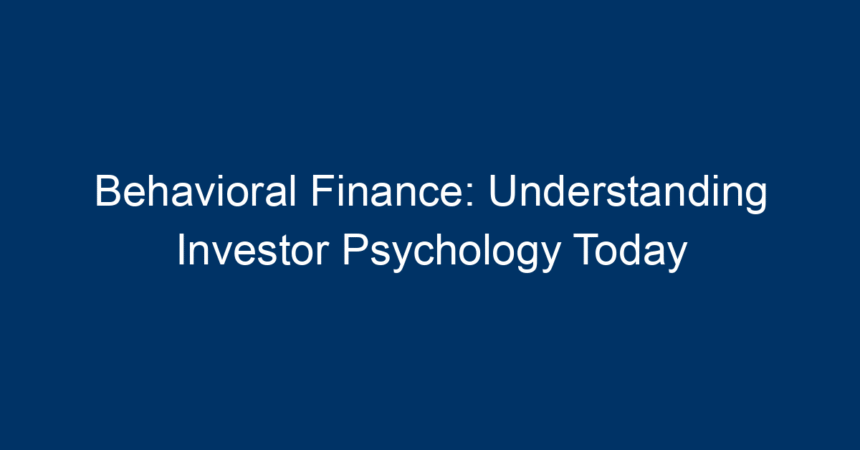In the fast-paced world of investing, decisions are often driven by more than just fundamental analysis and empirical data. Behavioral finance, a field that blends psychology and finance, plays a crucial role in understanding how emotions and cognitive biases influence investor behavior. This article delves into the intricate relationship between psychology and investing, exploring the various aspects of behavioral finance and offering actionable insights for investors.
What is Behavioral Finance?
The Intersection of Psychology and Finance
Behavioral finance seeks to explain why investors often act irrationally, contrary to traditional financial theories that rely solely on market efficiency and rationality. It acknowledges that emotions, cognitive biases, and social influences shape investment decisions, leading to systematic deviations from expected financial outcomes. As global markets become increasingly interconnected, understanding these influences is more important than ever for both individual and institutional investors.
Common Misconceptions
One common misconception is that behavioral finance implies that investors always act irrationally. In reality, it acknowledges a spectrum of behaviors, ranging from purely rational decisions to extreme biases. Recognizing this spectrum is essential for fully grasping the complexities of market dynamics.
Key Concepts of Behavioral Finance
1. Cognitive Biases
Cognitive biases are systematic patterns of deviation from norm or rationality in judgment. They significantly influence investor decisions. Some notable cognitive biases include:
- Overconfidence Bias: Investors overestimate their knowledge and abilities, leading them to take larger risks.
- Anchoring: This bias involves placing too much emphasis on the first piece of information encountered, which can skew future decisions.
- Loss Aversion: Investors are more affected by potential losses than by gains, causing them to hold onto losing investments longer than advisable.
2. Emotional Influences
Emotions can heavily impact decision-making in the financial realm. Fear and greed often drive market trends, leading to phenomena such as market bubbles and crashes. Recognizing these emotional triggers enables investors to prepare for and mitigate their effects on investment strategies.
3. Herd Behavior
Herd behavior refers to the propensity for individuals to mimic the actions of a larger group, often without independent analysis. This phenomenon can lead to market volatility and irrational spikes in asset prices. Behavioral finance studies how herd behavior contributes to market anomalies.
The Influence of Social Factors
The Role of Social Media
In today’s digital age, social media platforms have transformed how investors access information and interact with one another. Websites like Reddit and Twitter can amplify sentiments, causing stocks to rise or fall dramatically. Understanding this dynamic is crucial for modern investors.
Peer Influence and Networking
Investors often look to peers for guidance, which can lead to a collective mindset that either mitigates or exacerbates emotional influences. Building a supportive network of informed peers can help investors navigate the psychological challenges posed by behavioral finance.
Case Studies in Behavioral Finance
The Dot-Com Bubble
The late 1990s and early 2000s provide an excellent case study in behavioral finance, illustrating how overconfidence and herd behavior contributed to the dot-com bubble. Many investors disregarded fundamental analysis, following trends and euphoria surrounding internet-based companies. When the bubble burst, it showcased the consequences of neglecting rational investment principles.
The 2008 Financial Crisis
The 2008 financial crisis is another prime example of the implications of behavioral finance. During this period, loss aversion and herd behavior led to a massive sell-off in the housing market and a subsequent global recession. By recognizing the psychological elements at play, investors and regulators can better prepare for future market disruptions.
Strategies to Combat Behavioral Biases
1. Self-Awareness
The first step in combating biases is self-awareness. Investors should regularly evaluate their emotional responses to market fluctuations and identify any cognitive biases that may be influencing their decisions. Keeping a trading journal can be a valuable tool for this purpose.
2. Set Clear Goals
Establishing clear financial goals can help reduce impulsive decisions driven by short-term market trends. An investment strategy aligned with long-term objectives encourages a disciplined approach, minimizing the impact of emotional influences.
3. Diversify Your Portfolio
Diversification is a key strategy for reducing risk and mitigating the impact of biases. By spreading investments across various asset classes, sectors, and geographical regions, investors can create a buffer against emotional decision-making influenced by specific market events.
4. Seek Professional Guidance
Consulting with financial advisors or behavioral finance professionals can provide valuable insight and support in making informed investment decisions. These experts are equipped to recognize and navigate cognitive biases effectively.
Conclusion: Embracing Behavioral Finance
The rise of behavioral finance highlights the need for investors to understand the psychological factors influencing their decisions. By acknowledging cognitive biases, emotional influences, and social dynamics, investors can make more informed choices tailored to their long-term objectives.
Actionable Insights
- Educate Yourself: Understanding the basic principles of behavioral finance can empower your investment decisions.
- Monitor Your Emotions: Recognize your feelings during market fluctuations and how they impact your choices.
- Stick to Your Strategy: Align your investment strategy with well-defined goals and resist the urge to deviate based on market noise.
- Consult Experts: Don’t hesitate to seek help; a professional’s perspective can provide clarity.
By applying the insights from behavioral finance, investors can enhance their understanding of market dynamics and make decisions that are not only rational but also aligned with their financial goals. In a world driven by emotions and cognitive biases, it’s vital to equip yourself with the tools to navigate the complexities of investing effectively.




